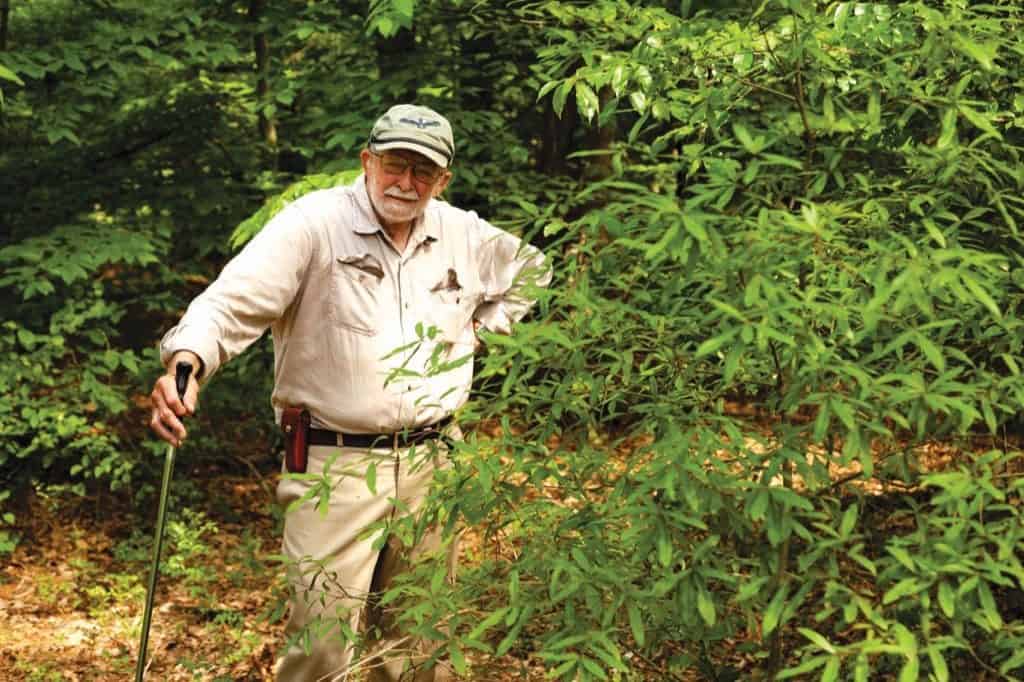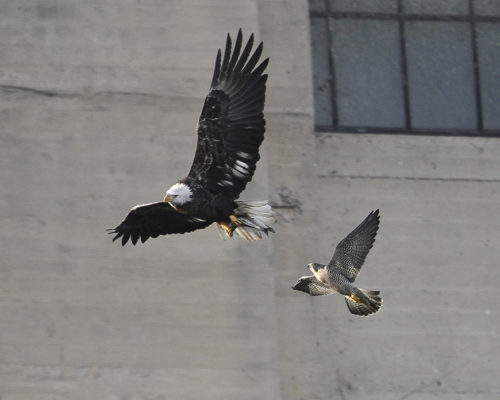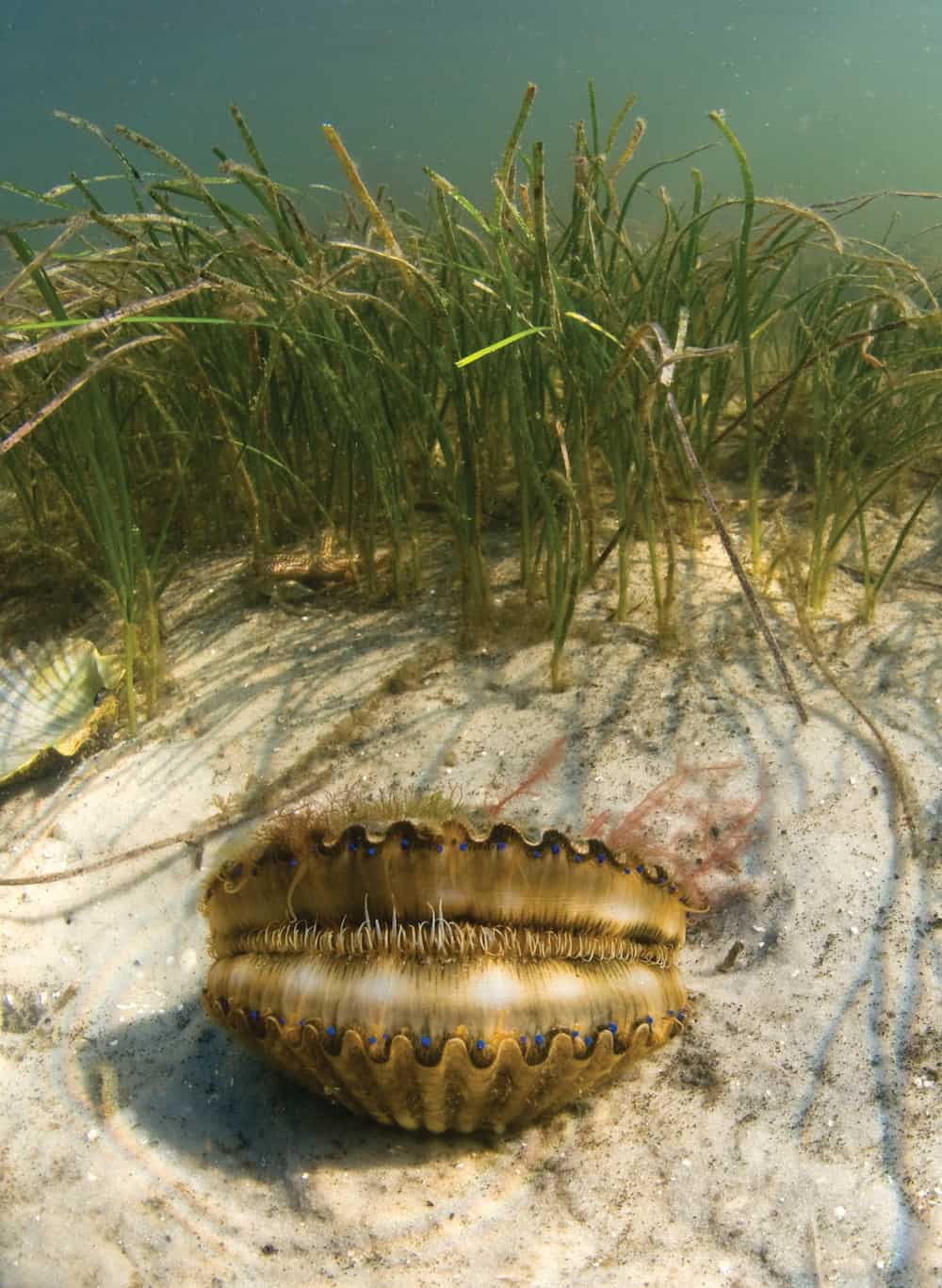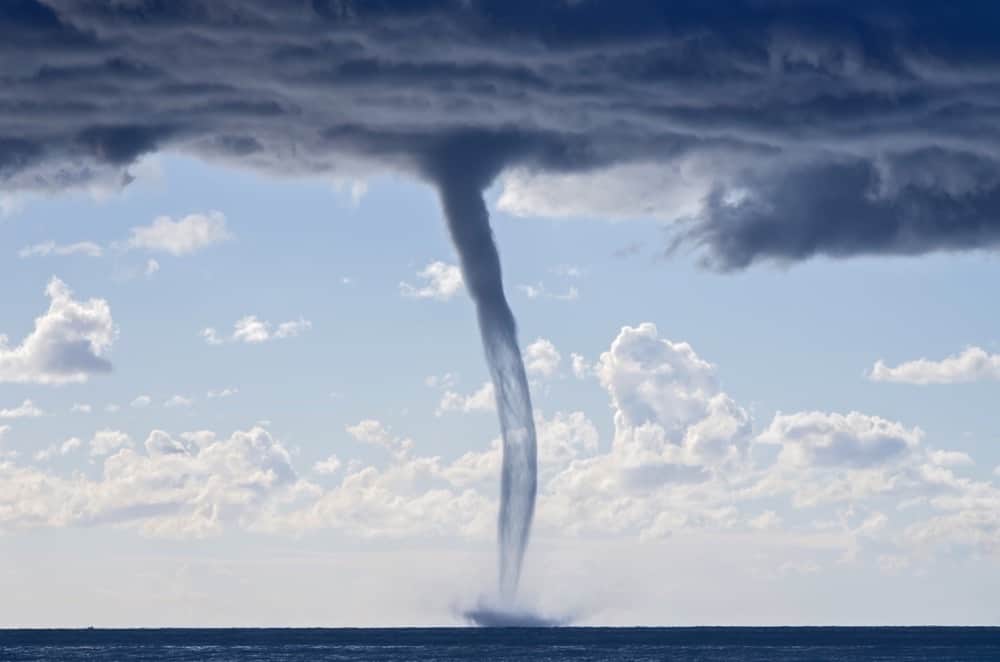Hope springs eternal in the persistence of Nick Carter.
Walking with Nick Carter through his thirty-three acres of greenwood boughs and shimmering leaves, a bog fed by a vernal spring, all set on the upper reaches of the Choptank River, is to experience a burgeoning forest through the eyes of its steward. One who also happens to be a legendary naturalist, a champion for the Bay, salty to the bone, irreverent, funny, and always unflinchingly honest.
It is early summer, and Nick Carter leads the way, clearly happy in his element—shin-deep in the muck, walking stick for balance. The lush canopy sways with the wind, and streaks of sunlight flare through the hardwoods and pine, brightening the skunk cabbage and sphagnum moss that thrive in the damp leaf duff. He is naming the plants, pointing out rattlesnake plantain orchids growing wild just off the footpath and describing the patch of pink lady’s slipper up the way. He is a human encyclopedia, not just on the inhabitants of this natural world, but on how the ecosphere works together as a sustaining system, how it breaks itself down, re-nurtures itself, and becomes more diverse and richer over time. He is fascinated with the mechanisms of natural recycling and hydrologic systems—how a brush pile filters rainwater, forcing it to slow down and disperse; how an engraver beetle creates an artistic pattern on a dead cedar tree, gradually turning it to compost; and how the soft forest floor acts like a giant sponge, capturing surface water and nutrients, filtering them, and enabling life to prosper.
Carter and his wife Margaret bought their property in 1966. He’s shown me photos. Originally it was a somewhat bare-bones farmhouse surrounded by poor, sandy soil, unfit for tillage.
“It was only being farmed for the subsidy,” he tells me.
He points to a rotting stump: “There was hardly a tree on the front half of the property. But the single red maple that stood right here spawned hundreds more.”
Looking around, he huffs in satisfaction.
“Margaret and I agreed to let the land turn natural. We both knew that forest is the best land use for the Bay. That was 53 years ago. So, we terminated the farming agreement. First, the weeds started coming back—trumpet vine, broom sedge—then we started to get some little pine trees. It took fifteen years for the hardwoods to get a footing. Southern red oak and willow oak came first, ’cause they have the smallest acorns, and the squirrels and birds often misplace or lose them. Then came the sweetgum, white oak, maples.”
Carter has a deep, throaty voice, but within the intimacy of his woods he seems to speak in a reverential whisper.
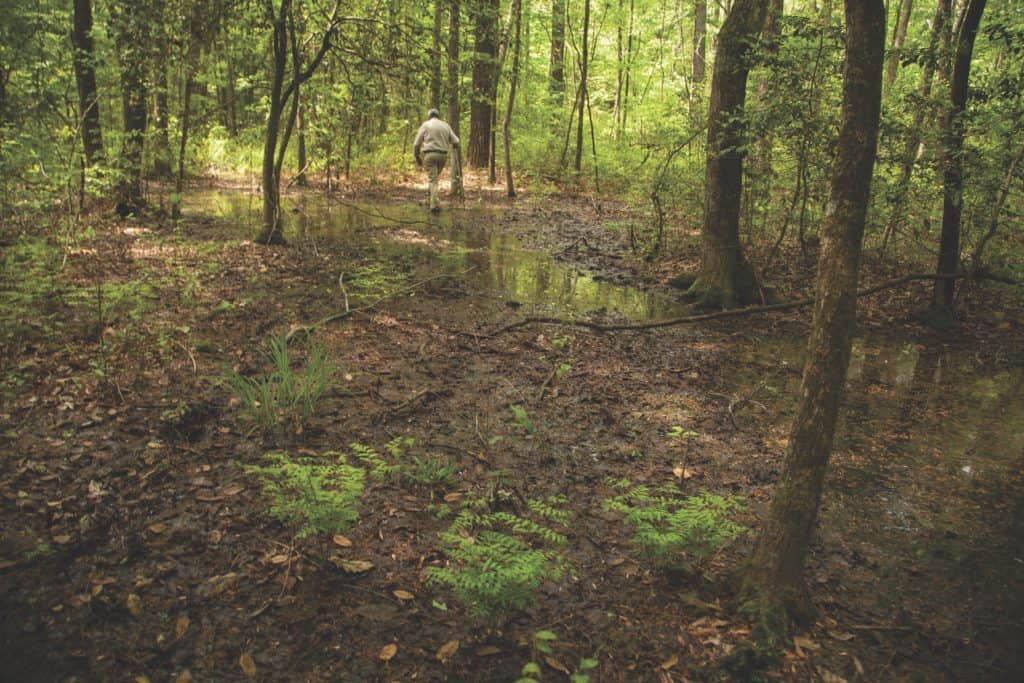
“There was a ditch running through the property and I blocked it with some stumps, and when it’s wet, we have this thriving bog. And on the property downgradient from us, there is Rosemary’s spring, where the groundwater absorbed by and through our restored forest, bubbles out cool and clear…”
My wife loves the rain,” he says. “Margaret relishes when this dry, droughty soil is wet and all the plants flourish.” He plucks a damp, elongated leaf from a plant and shows it to me. “This is called a New York fern,” he says, a mischievous glint in his eye. “They say it’s called that because it’s pointed at both ends, like a New Yorker’s head.”
It was 1965, a year before they bought their farm, when he began working at the Maryland Department of Game and Inland Fish, which soon after became the Department of Natural Resources. Growing up near Norfolk, Nick had obtained a biology degree from Old Dominion and a master’s in fish ecology from the University of Washington and began to put these to work. For thirty-five years he served the state. Shortly before his retirement in 2000, the Maryland Department of Natural Resources named its library after him: the W.R. “Nick” Carter III Library.
During his career, Carter played an increasingly influential role in key policy issues, relying on science to advocate for what he describes as “the silent voices out there, the rivers, the ecosystem.” When the Conowingo Dam expanded its use of hydropower generation and shad and herring were suffocating by the thousands, he found a solution. When it became apparent that the state intended to heavily increase its dredging to deepen the Bay’s shipping channel to better compete against Norfolk, he helped craft a balanced approach for the rehabilitation of Poplar Island—using the millions of cubic yards of dredge material and creating what is now over 1,000 acres of low marsh, high marsh, and upland habitat. Carter annually conducted fish surveys using seine and gill nets, weirs he constructed, and other methods, and he can argue convincingly that the Choptank River is the most important striped bass spawning ground on the Atlantic Coast. Over time, as he describes it, he became the person at DNR who wrote the fisheries agency’s comments on permit applications.
“Whenever there was a proposed development that would modify the aquatic environment,” he explains, “I became the one to provide the comments. It was very broadening work and went on for two decades. I had to deal with US Department of Agriculture, the state and federal highway commissions, the US Army Corps of Engineers, private developers, you name it. I was privileged to be the advocate, the voice for the land and the water. I owe a great debt to my scientist friends and colleagues all over the region who would help me prepare the data and the science to support my positions. I lost more battles than I won. But we won quite a few. And moved the needle on many others. Though after a while, I must say, when they’d hold a meeting on a project it got to be like, “Oh shit, here comes Nick again with the bad news…”
Still, he was always able to buffer his stewardship with a sense of humor. When the nutria, a South American pest similar to a beaver, began to threaten our marshes, he held nutria barbeques. He also became known for spicing up pot-luck dinners with marinated possum and racoon ready for the grill.
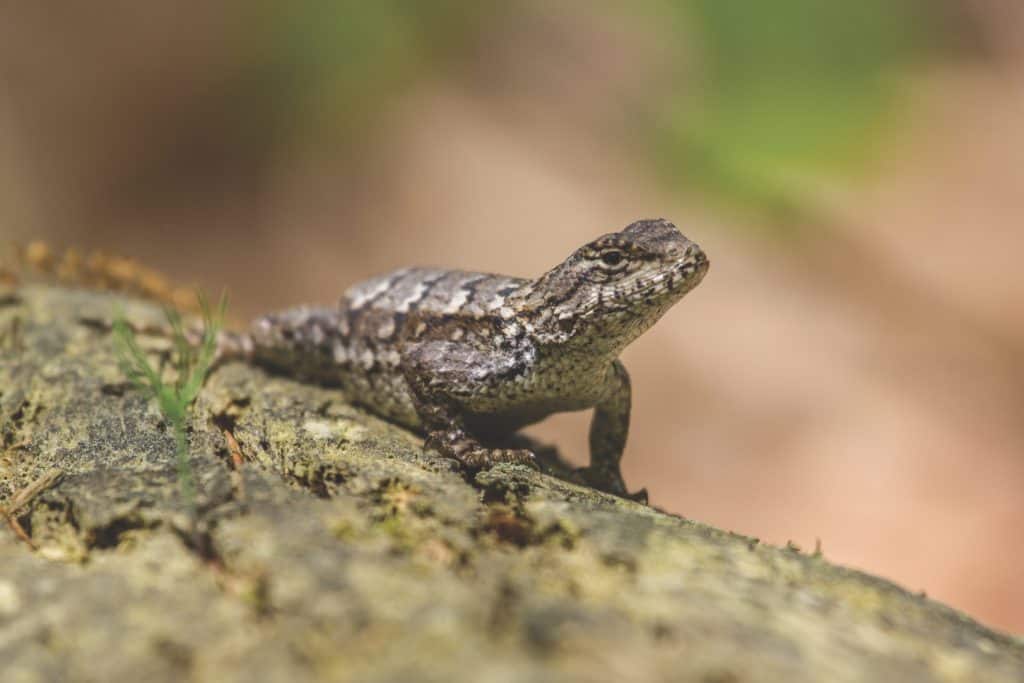
Throughout his career, Carter has loved to teach. High school and college students routinely spend a day with Nick walking his land or exploring the creeks and rushes of the Choptank aboard his skiff. He works with educational programs at Salisbury University, ShoreRivers, Adkins Arboretum, Gunston School, the Master Naturalist Program (administered by DNR), and many others. He has invented or salvaged an array of teaching props, including a way to measure and feel the pincher strength of a blue crab’s claw. When a right whale washed up on shore years ago, he salvaged its vertebrae using a chain saw. The bleached remains adorn his farm as sculpture to this day. Carter’s guided ecology trips on the upper rivers, infused with his mirth and vast knowledge, have become sought-after. At the non-profit ShoreRivers’ film festival last year, a half-day river trip guided by Nick Carter sold at silent auction for $2,000. When the second-place finisher learned he hadn’t gotten it, he asked Nick if he could purchase a second trip.
In 2015, Bay naturalist and writer Tom Horton and photographer Dave Harp published Choptank Odyssey, a masterful book of essays and photographs of the Choptank River. The initial essay, describing the headwaters of the river, is all about Nick and Margaret’s property. The first sentence reads: “If I were the Choptank River, it’s on Nick and Margaret Carter’s place I’d want to be born….” Horton and Harp went further, and chose to dedicate the book to “ W.R. Nick Carter III, scientist, educator, poet, steward—a clear and persistent voice for the Choptank River.”
The first time I met Nick was in 2008. That September he offered to show me how to harvest the wild rice that grows in Watts Creek, a tributary of the upper river. As we paddled along that day, he pointed out the plants that filled the wetlands: yellow spatterdock lily, cardinal flower, and orange jewel weed, a favorite of hummingbirds and an antidote for poison ivy, he explained. As kingfishers and wood ducks outraced us, he began lamenting over how much of the forests on the surrounding land had been removed. “What you see from the water,” he pronounced, sweeping his arm across the landscape, “is an illusion. From the river, the woodlands appear thick along the shore, but the trees only exist on the very thin edge of these farms. Less woods and more farmland translates into more nutrients washing into our rivers. More pollution.”
He nodded forward as he poled the boat. Ahead, the willowy rice stalks glistened like green lace in the morning. “Population drives environmental degradation,” he continued. “We cut the forests to create more and more food. Maybe you’ve heard of my campaign to reduce overpopulation? Condoms for a Cleaner Chesapeake?” Nick reached into his pocket, smiling, and pulled one out. The package read “Save the Bay.”
“I’ve been very lucky in my life,” Carter ruminates. “Been able in my work, and in my whole life, to follow and put into practice my beliefs.“ We sit after our walk, sharing tea in the natural garden outside their renovated farmhouse. “The kids grew up here. My daughter named it Druid Hall, after she learned that Druids were the priests of the earth. And Margaret did all this,” he motions around. “Look at all these beautiful pollinators she planted—that field of asters, those coreopsis, these waves of milkweed for the monarchs. You know it can take up to 1,000 years to create one inch of topsoil. Nature takes her time. It will take another 250 years for all this to turn into an old growth forest. Right now, we have over 200 species of plants, 80 species of birds, over 25 different mammals and 25 reptiles and amphibians that inhabit our property. And as it matures, it will only become more diverse. We’re hoping to find the right people to turn this over to, who will protect it and allow it to continue to unfold as it remakes itself over and over. We will all be needing more old growth forests.”
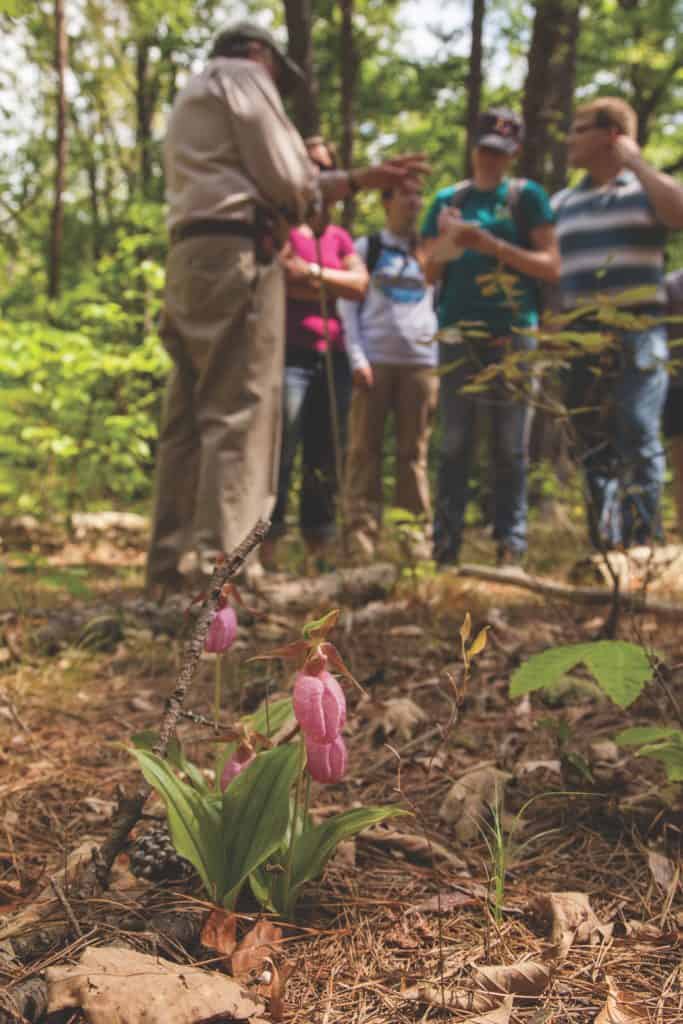
Looking out to 2050, Carter is concerned. “One aspect of public policy I’ve observed,” he says, “and it’s pretty near a law, is that as more development lurches forward, government will be forced to ratchet down environmental controls to accommodate it. And more people will require more development. I don’t like being regulated any more than the next fella. I want to pee off my porch if I feel like it. Run naked through the woods if I choose. But these natural systems need protection. Need regulation. And when you interface population growth with increasing climate change, more extreme storm events, more and fiercer runoff—well, these forests, these natural systems become more important than ever. They serve as essential buffers, sanctuaries that can help balance adverse forces produced by harmful environmental changes.”
Nick is a fan of the naturalist writer Aldo Leopold, and particularly fond of an essay in Leopold’s Sand County Almanac, titled “Odyssey.” It tracks an atom, X, through geologic time. Initially buried in rock in the Paleozoic, X is eventually sucked into a root that’s found a crack in the rock. The root is eaten by a mouse, the mouse taken by a hawk, and X is transformed and reincarnated thousands of times through the ages as it is recycled as part of a continuum in a natural system. “It is really so simple,” Nick tells me. “To let nature mostly alone, do nothing as much as we can, let it thrive, and when we have to modify it, do it wisely; take the long-term view, knowing that we are, in the end, wholly dependent on a naturally functioning nature. It is not a concept that comes easily to folks. Few people seem to understand it, though it is essential if we are to survive. If more people could just grasp it and embrace it in their lives and in our policies, I’d have real hope.”

